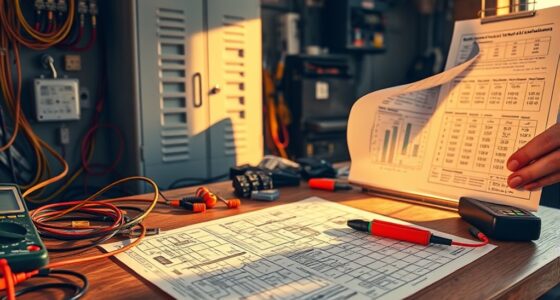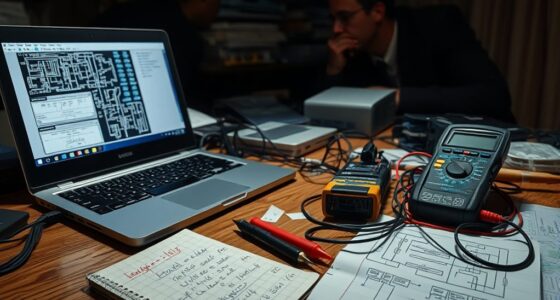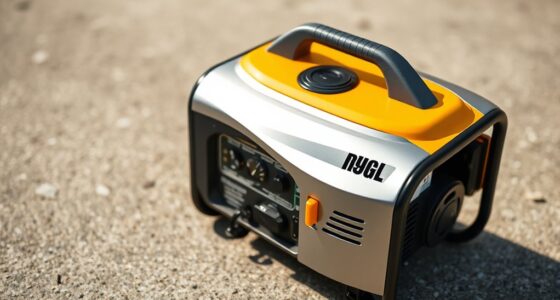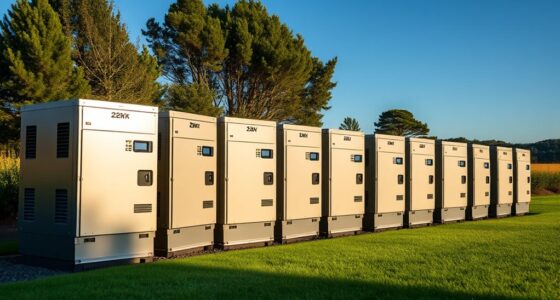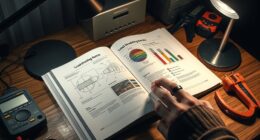Ignoring the difference between starting and running watts can lead to costly damage, higher fuel bills, and unnecessary oversizing of your generator. Many believe that equipment always needs maximum wattage, which often results in overestimating power needs. This oversight can shorten the lifespan of appliances and increase expenses. To avoid these hidden costs, it’s essential to accurately assess your load and match wattages properly. Keep exploring to uncover how you can save money and prevent damage.
Key Takeaways
- Oversizing generators based on maximum starting wattage leads to unnecessary costs and higher fuel consumption.
- Ignoring surge requirements can cause equipment damage and reduce lifespan if not properly accounted for.
- Underestimating startup wattage risks overloads and equipment malfunctions, increasing repair costs.
- Proper wattage matching and surge margin estimation prevent hidden costs and extend equipment longevity.
- Regular maintenance and accurate load assessment help avoid hidden expenses from damage and inefficient operation.
Understanding the Difference Between Starting and Running Watts
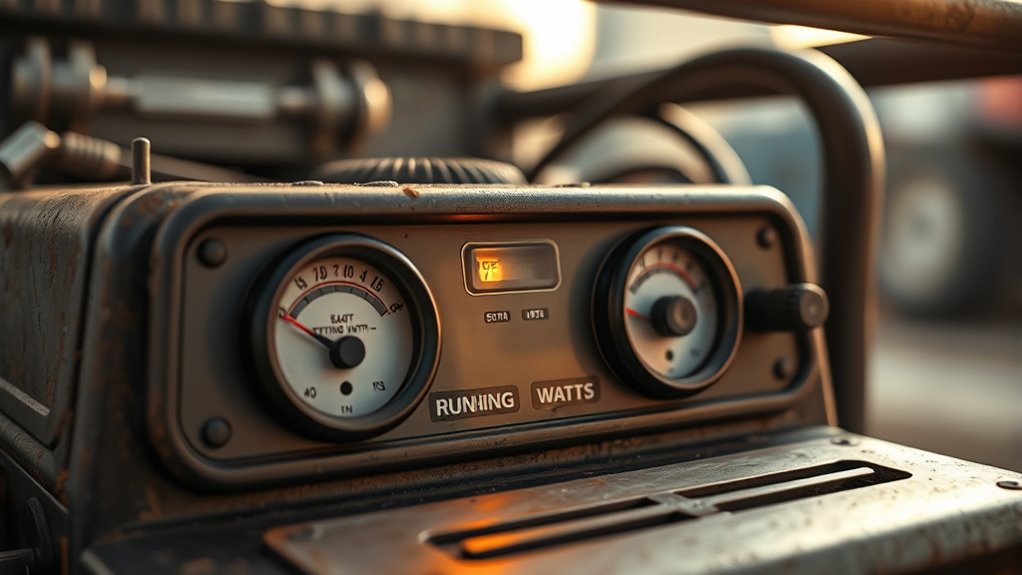
Understanding the difference between starting and running watts is essential when selecting a generator or power source. Starting watts refer to the initial surge needed to power equipment with motors or compressors, while running watts are the continuous power required during operation. One key factor to contemplate is the power factor, which influences how efficiently your device uses electrical power. A poor power factor can lead to increased starting wattage, stressing your generator. Additionally, voltage stability is critical; fluctuations during startup can cause equipment to malfunction or become damaged. By understanding these differences, you ensure your generator can handle the initial surge without overloading, maintaining consistent voltage levels. Properly managing power consumption helps you choose the right size generator, avoiding unnecessary costs and ensuring reliable operation.
Common Myths That Lead to Overspending

Many people overestimate their power needs or overlook surge requirements, leading to unnecessary expenses. Assuming your equipment always requires maximum power can cause you to buy a more powerful generator than you actually need. Understanding these myths helps you avoid overspending and choose the right size for your needs. Additionally, selecting a generator with appropriate capacity ensures you maintain performance without overspending.
Overestimating Power Needs
One common mistake that leads to overspending when selecting a generator is overestimating your power needs. When you assume you need a higher wattage than necessary, you end up paying more upfront for a larger battery capacity and reduced fuel efficiency. To avoid this, consider these points:
- Listing only essential appliances and their starting watts.
- Factoring in continuous running watts, not surge power.
- Choosing a generator that matches your typical load, not the maximum.
- Recognizing that overestimating often results in unnecessary costs and inefficiency.
- Understanding the importance of decoding modern slang to better communicate your needs and avoid misunderstandings when seeking advice or comparing products.
Ignoring Surge Requirements
Ignoring surge requirements is a common mistake that can lead to overspending on a generator. When transient loads or initial startup surges occur, your equipment demands more power than the running watts. Without proper surge protection, your generator may be undersized, risking damage or failure. To avoid this, consider the surge wattage of each device and choose a generator that can handle these peaks. Here’s a quick reference:
| Device Type | Starting Watts | Running Watts | Surge Protection Needed |
|---|---|---|---|
| Refrigerator | 2200 | 700 | Yes |
| Power Tools | 3000 | 1500 | Yes |
| Sump Pump | 2500 | 1250 | Yes |
| Microwave Oven | 1200 | 1000 | No |
Properly accounting for transient loads guarantees your generator provides reliable surge protection without overspending. Additionally, understanding surge requirements helps to ensure your equipment’s longevity and optimal performance.
Hidden Costs of Ignoring Wattage Ratings
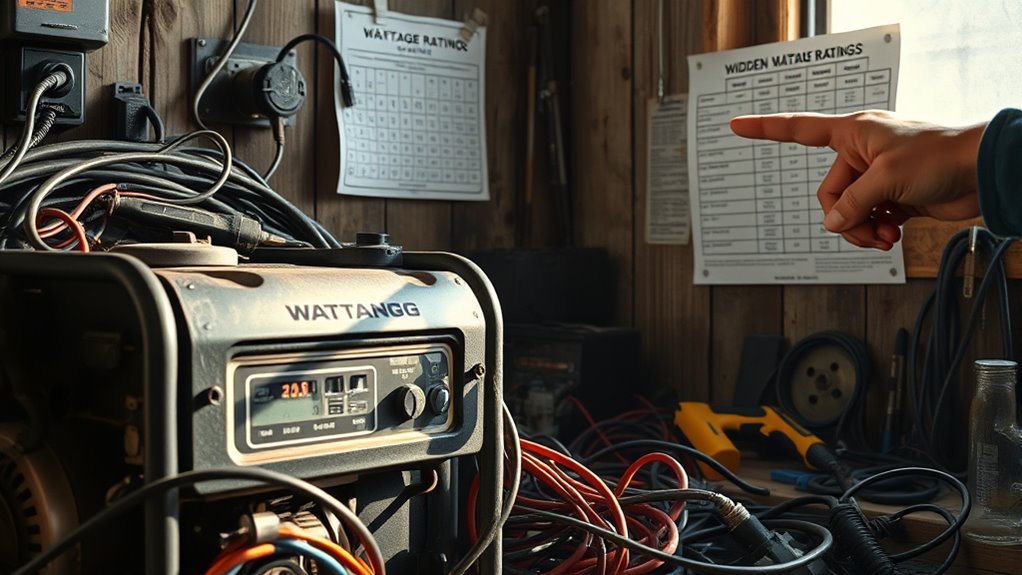
Overlooking wattage ratings can lead to unexpected expenses and equipment failures. When you ignore proper wattage matching, you risk damaging devices or overloading your generator. This can also impact fuel efficiency, causing you to burn more fuel than necessary. Additionally, running equipment beyond recommended wattage can increase noise levels, making operation disruptive. Here are some hidden costs to watch out for:
Ignoring wattage ratings risks damage, higher costs, and disruptive noise.
- Higher repair or replacement costs due to equipment damage
- Increased fuel consumption from inefficient operation
- Excessive noise that disturbs your environment
- Reduced lifespan of your generator and connected devices
How to Accurately Assess Your Power Needs
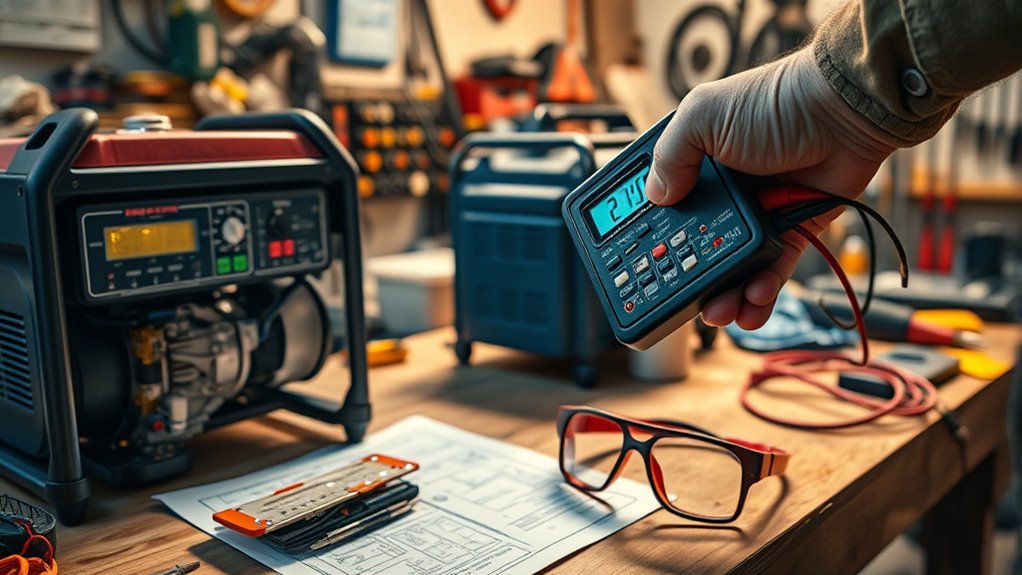
Accurately evaluating your power needs is essential to prevent overloads and ensure your equipment runs smoothly. Start by listing all devices you plan to power, noting their starting and running wattage. Consider the battery capacity if you’re using a portable generator, as it determines how long you can operate without refueling or recharging. To avoid unnecessary costs, factor in fuel efficiency by estimating how much fuel your generator consumes at different loads. This helps you select a generator that matches your actual needs without overspending on excess capacity. Keep in mind that starting watts are higher than running watts, so add a margin for surge power. Doing this precise assessment guarantees you choose a generator that’s reliable, efficient, and cost-effective for your specific requirements. Additionally, understanding Vetted – Flat Iron Bike options can inform decisions on portable power sources for mobile or outdoor use.
Practical Tips for Choosing the Right Generator

Choosing the right generator starts with understanding your specific power needs and how you’ll use it. To make an informed choice, consider these practical tips:
- Estimate your total load to ensure the generator can handle your starting and running watts without overloads.
- Prioritize fuel efficiency by selecting models that consume less fuel, saving you money over time.
- Check noise levels to find a generator that operates quietly, especially if you plan to use it in residential areas.
- Evaluate portability and size, ensuring it fits your space and transport needs without sacrificing power capacity.
- Understand the importance of proper tea brewing techniques to maximize the performance and longevity of your generator.
Avoiding Damage and Maximizing Efficiency
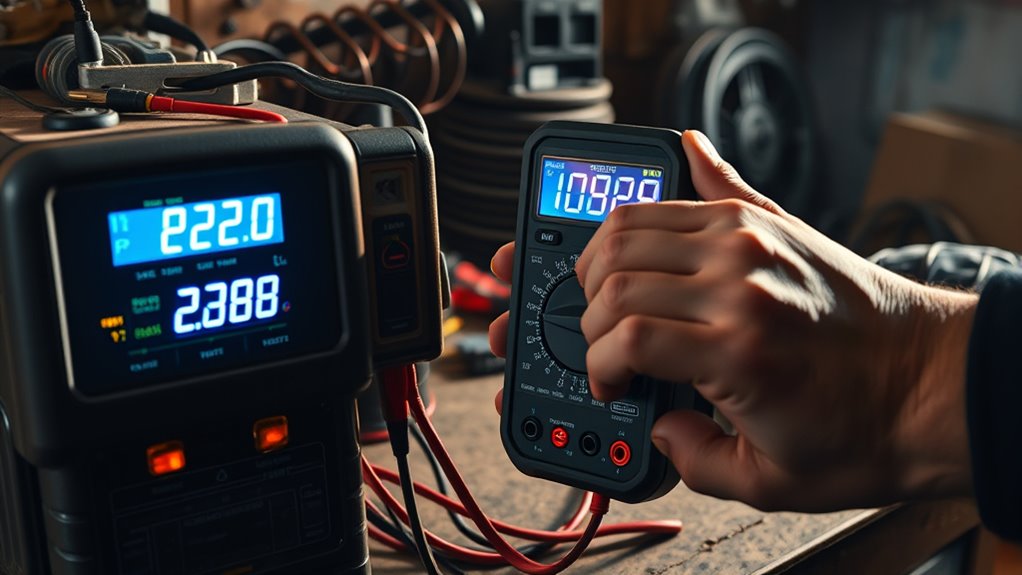
To avoid damaging your equipment and guarantee maximum efficiency, you need to manage power properly. Regular maintenance keeps your generator running smoothly and prevents unexpected breakdowns. By staying attentive to these practices, you’ll protect your gear and get the most out of your generator. Additionally, understanding the importance of proper power management can help prevent common issues related to starting watts and running watts, ensuring your equipment operates safely and effectively.
Proper Power Management
Proper power management is essential to prevent damage to your equipment and guarantee maximum efficiency. When managed correctly, you can improve fuel efficiency, reduce noise levels, and extend the lifespan of your devices. Here are four key tips:
- Avoid overloading your generator, which strains the engine and wastes fuel.
- Use the right-sized generator for your load to optimize fuel consumption and minimize noise.
- Turn off equipment when not in use to prevent unnecessary power draw and noise.
- Monitor power usage regularly to identify inefficiencies and prevent damage from power surges.
- Incorporating essential oils for equipment maintenance can help reduce dust and improve airflow, potentially extending the longevity of your devices.
Regular Equipment Maintenance
Regular equipment maintenance is essential for preventing damage and ensuring your generator operates at peak efficiency. Regularly inspecting and cleaning your equipment helps maintain ideal fuel efficiency, saving you money and extending its lifespan. Well-maintained parts reduce strain on the engine, which also minimizes noise, making your generator quieter during operation. Changing oil, replacing filters, and checking coolant levels are simple steps that prevent overheating and wear. Keeping things in good shape helps avoid unexpected breakdowns and costly repairs. Additionally, a properly maintained generator runs more smoothly, uses fuel more efficiently, and produces less noise, making it more pleasant to use. By staying consistent with maintenance, you’ll maximize your generator’s performance and longevity, ultimately reducing your overall costs. Real couples often share how consistent care and communication contribute to their long-term happiness and reliable partnership.
Frequently Asked Questions
How Can I Identify the True Starting Wattage of My Appliances?
To identify the true starting wattage of your appliances, check the manufacturer’s label or manual for wattage measurement details, especially the surge or starting watts. When an appliance requires an initial power boost, it experiences an appliance surge. Use a wattmeter or clamp meter to measure actual wattage during startup. This helps you avoid underestimating power needs and guarantees your generator can handle the initial surge comfortably.
What Are the Long-Term Financial Impacts of Choosing the Wrong Generator Size?
Choosing the wrong generator size can lead to higher maintenance costs over time, as an underpowered unit strains to handle your needs, and an oversized one wastes fuel and increases wear. This mistake can also lower resale value if the generator shows signs of overuse or damage. To avoid these issues, select a generator that matches your power requirements, ensuring longevity, efficiency, and better financial returns in the long run.
Are There Specific Brands or Models Known for Wattage Accuracy?
Some brands are renowned for wattage accuracy and model precision, such as Honda, Yamaha, and Generac. These brands prioritize reliability, ensuring their generators deliver consistent power output. When selecting a model, look for those with positive reviews on brand reliability and precise wattage ratings. This way, you avoid under- or overloading your equipment, saving you money and reducing maintenance costs in the long run.
How Do Environmental Factors Influence Generator Performance and Costs?
Environmental factors can reduce your generator’s efficiency by up to 30%, impacting fuel efficiency and increasing costs. High temperatures, humidity, or altitude strain the engine, causing it to work harder. For example, running a generator at high altitude can decrease its power output by 10-15%. To save money, you should consider environmental conditions when choosing and maintaining your generator, ensuring peak performance and minimizing unexpected expenses.
What Safety Precautions Should I Take When Operating High-Wattage Equipment?
When operating high-wattage equipment, you should prioritize electrical safety by guaranteeing all connections are secure and grounded properly. Always wear protective gear like gloves and safety glasses to prevent electrical shocks and injuries. Keep the area dry and clear of conductive materials, and never overload your generator. Regularly inspect cords and equipment for damage, and follow manufacturer instructions to avoid accidents and ensure safe, efficient operation.
Conclusion
By understanding the true difference between starting and running watts, you can avoid costly mistakes. For example, selecting a generator that only meets your running watts might leave you powerless during startup surges, like a fridge compressor kicking on. Take the time to assess your needs accurately and choose wisely. Doing so guarantees your appliances run smoothly, saves money, and prevents damage—keeping your power supply reliable and efficient when you need it most.


